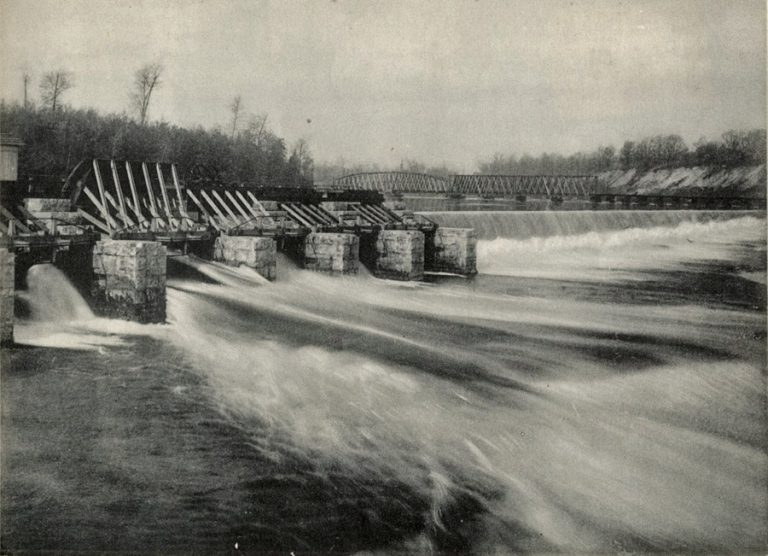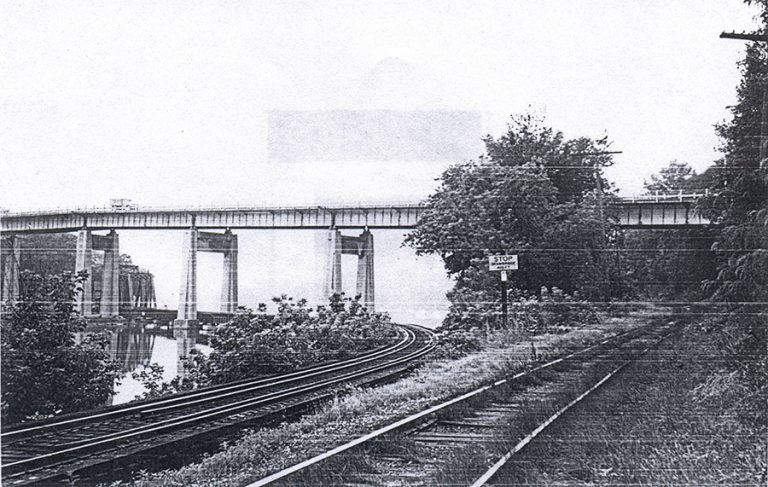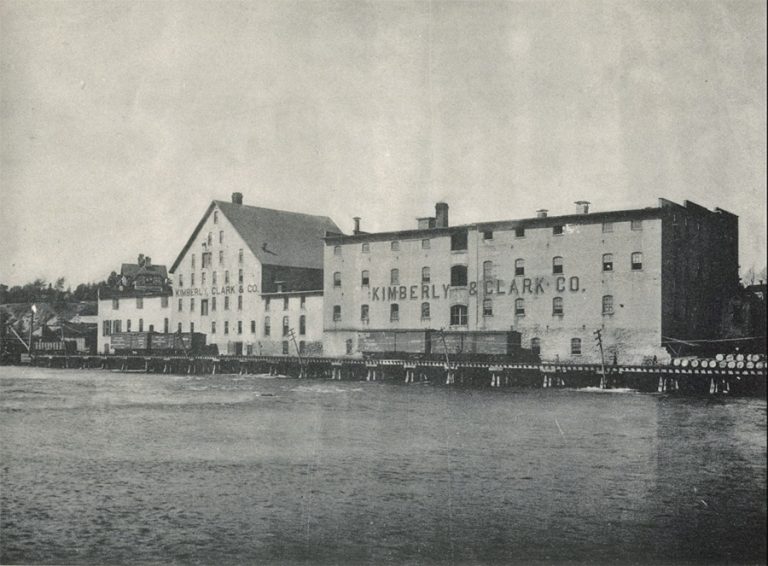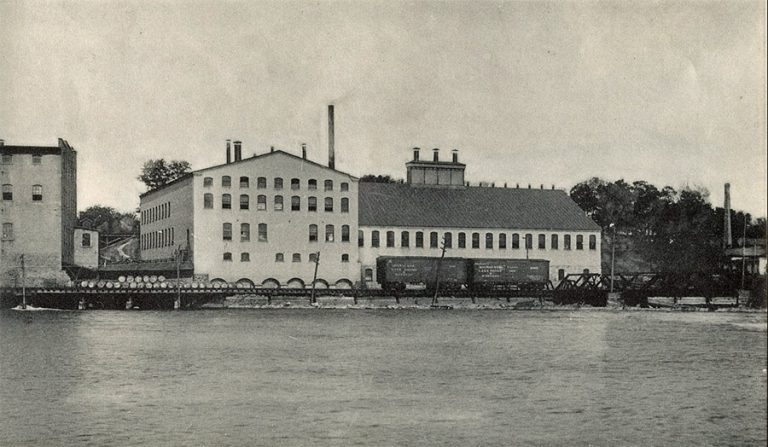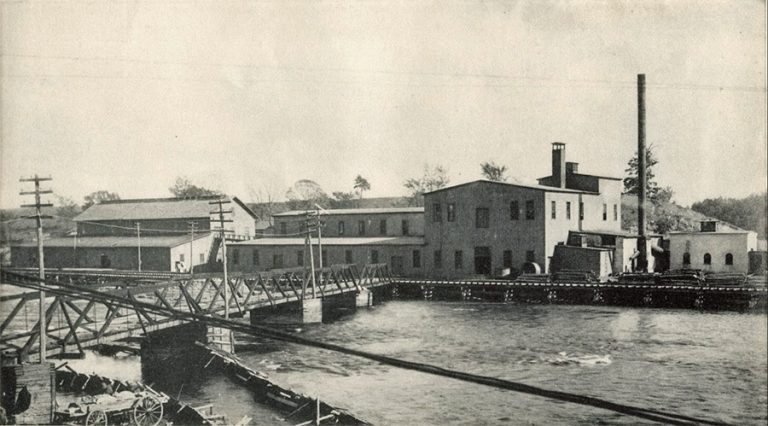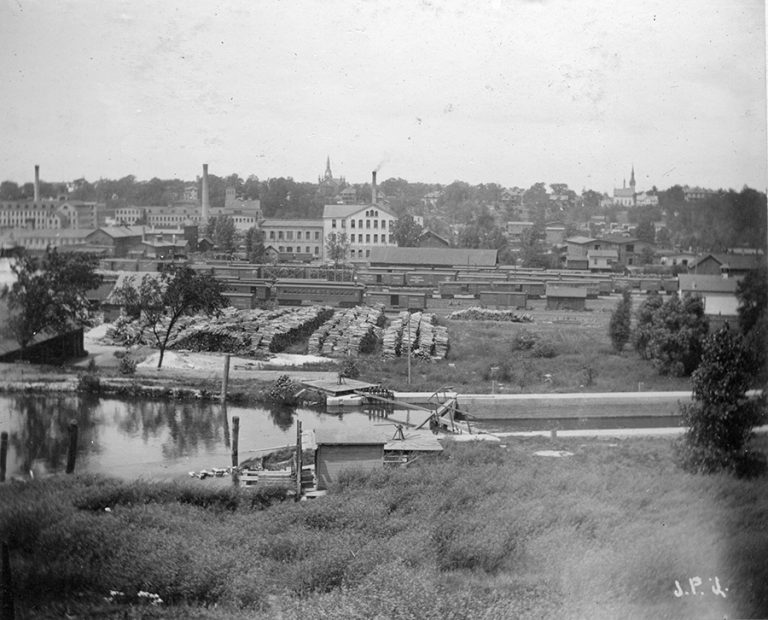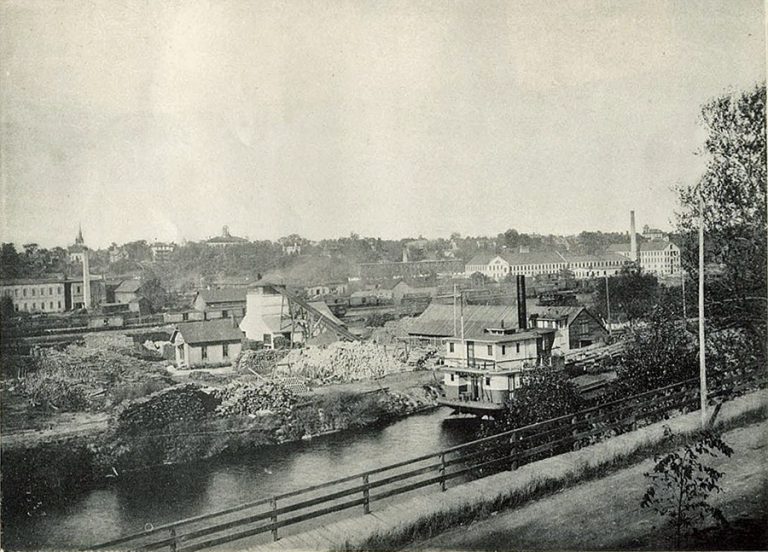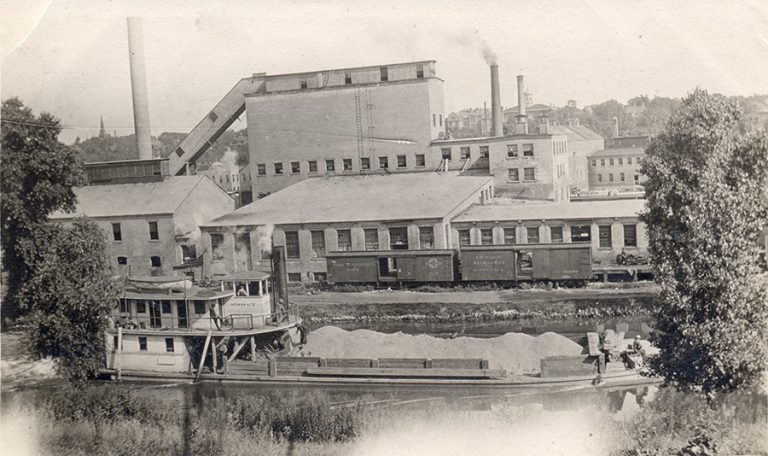The Milwaukee & Northern – Appleton Branch
The M&N constructed a 4.7-mile branch line from Menasha down into ‘the Flats’ at Appleton, Wis., in 1880 (the Appleton Branch). By the mid-1880s, the Menasha, Appleton and Neenah Branches were collectively referred to as the Appleton Branch on timetables.
It was also the Appleton Branch of the Superior Division of the Chicago, Milwaukee & St. Paul (CM&StP), or Milwaukee Road (MILW), after they took over the M&N in 1893. The MILW reorganized as the Chicago, Milwaukee, St. Paul & Pacific (CMStP&P) in 1928.
Scroll down to find information regarding the Appleton Branch. Use this button to find information regarding a customer on the Appleton Branch.
Swing Bridge Over the Fox River at Appleton, Wis.
The M&N completed this swing bridge in January of 1880. We aren’t sure when, but this bridge was later replaced with a new one built by the MILW. This bridge was approximately 3.9 miles from the Menasha depot, and approximately 7/10th of a mile from the Appleton depot.
In 1995, Larry Easton, co-founder of the MNRHS, wrote an article about the MILW swing bridge on the former M&N Appleton Branch. The article was illustrated with Larry’s own photographs, which he had captured on 27 July and 2 August 1966. The Neenah Historical Society has a photocopy of the article, and gave us permission to use it here. We would love to learn the whereabouts of Larry’s original photographs, in the hope that we can obtain better copies of them.
The Milwaukee Road Bridge over the Fox River in Appleton was a Nice Place to Visit in the Summer of 1966
by Larry Easton
“On July 12, 1879, the Menasha & Appleton Railroad [controlled by the M&N] was incorporated to build a branch line between the two towns of Menasha and Appleton. Construction began in the fall of 1879 and was completed in March 1880.
“The new railroad was immediately leased to the Wisconsin Central. The M. & A. R. R. was sold to the Milwaukee & Northern R. R. on July 10, 1880, with both railroads remaining under the control of the WC until July 31, 1882, when the leases were terminated. The Milwaukee & Northern operated as an independent railroad until June 26, 1893 when the entire railroad was sold to the Chicago, Milwaukee & St. Paul Railroad. The “Appleton Branch” remained Milwaukee Road property until the sale to the Soo Line in 1985. A portion of the line is still operated by the new Wisconsin Central, Ltd. railroad, but it has been several years since the last train rolled across the bridge into the “flats” in Appleton.
“I stumbled upon the bridge during the summer of 1966 when I was working in Appleton at the Allis-Chalmers plant in the flats. Since I had an hour for lunch, I would sometimes take my camera and photograph interesting buildings and trackwork when the weather was cooperative. I had often seen the bridge; and for a while I couldn’t find any easy way to get down to it. I finally stopped in the little park at the top of the hill and, much to my delight, found a long stairway leading down t the bridge tender’s cottage below. It was an easy climb down to the tracks. I was pleasantly surprised by the neatly kept buildings and surroundings.
“As I was soaking up the quiet and peaceful atmosphere (compared to the traffic above), the bridge tender, Herman Erdman, came out of the cottage to greet me. We had a short visit. Unfortunately, I didn’t take any notes, not thinking that sometime in the future I would want them for an article!
“I took the accompanying photos, and hurried back to work. Although I had planned to get back down to visit the bridge again, I never did. Now, I don’t want to. I would rather remember that pleasant day in 1966 – the way is used to be.”
Larry Easton – 1995
“Looking north form the south bank of the Fox River, the Milwaukee Road swing bridge is an imposing structure. With very little boat traffic on the river, the bridge tender had little to do other than visit with an occasional railfan or neighborhood kids. August 2, 1966.” Photograph and caption by Larry Easton, courtesy of Neenah Historical Society.
The Kimberly & Clark Co.’s Atlas, Vulcan, and Tioga paper mills.
These mills were served by the M&N, Milwaukee Lake Shore & Western (MLS&W), and Chicago & North Western (C&NW).
Looking northwest toward the Tioga (on the left) and Vulcan (on the right) paper mills in ‘the Flats’ at Appleton, Wis., in 1892. The Hearthstone can be seen atop the bluff in the background to the left. The C&NW spur runs along this side. The M&N and MLS&W tracks run along the far side. The second boxcar from the right is Wisconsin Central (WC), the third is C&NW. Photograph from Appleton Wis., Illustrated, 1892.
Looking north toward the Atlas Paper Mill in ‘the Flats’ at Appleton, Wis., in 1892. The Vulcan mill is partially visible on the left. The C&NW spur runs along this side. The M&N and MLS&W tracks run along the far side. The two boxcars are both MLS&W. The one on the right is MLS&W 4962. Photograph from Appleton Wis., Illustrated, 1892.
Looking southeast toward the Atlas Pulp Mill in ‘the Flats’ at Appleton, Wis., in 1892. The bridge connects this pulp mill to the Atlas Paper Mill. This mill stood at the west end of the island which was formed after the navigation canal was completed. The spur for this mill probably came off the M&N. Photograph from Appleton Wis., Illustrated, 1892.
Appleton, Wis., was Milepost 21 on circa 1885-1888 timetables, it was listed as Milepost 20 on an 1892 timetable.
The MILW, former M&N, yard in ‘the Flats’ at Appleton, Wis., circa 1898. The former M&N depot is just out-of-frame to the left. The C&NW, former MLS&W, yard runs parallel along the far side the MILW yard. This view is looking north from E. South River St. The piles of wood in the center of the scene belong to the J. H. Marston & Co. (later Marston Bros. Coal, Wood & Lime), a M&N/MILW customer. The large, cream-colored brick building near the center of the scene is the Appleton Woolen Mills. Appleton Lock No. 2 (historically Lock No. 16, counting from Green Bay) on the Fox River Navigation Canal is in the foreground. Photograph courtesy of Neenah Historical Society.
Looking northeast across ‘the Flats’ at Appleton, Wis., in 1892. The boat in the canal is the J. H. Marston. The J. H. Marston & Co. (later Marston Bros. Coal, Wood & Lime) stands in the middle of this scene. Their lime kiln stands to the left of center. The building partially visible behind the vessel is their coal shed. The M&N yard runs along the far side of the Marston facility. The MLS&W yard is beyond the M&N. The Appleton Woolen Mill is partially visible in the background to the left. Telulah Paper Co. stands in the background to the right. Patten Paper Co. can be seen to the left of Telulah. Lawrence University’s main hall can be seen atop the bluff in the background (above and to the left of the lime kiln). Photograph from Appleton Wis., Illustrated, 1892.
The steam propeller J. H. Marston was built at Appleton, Wis., in 1881 or 1882. It had a 135’ keel, 24’ beam, 4.5’ or 5’ draft, and a capacity of 117 gross tons. It routinely hauled lime stone from Clifton, later High Cliff, across Lake Winnebago and down the Fox River to the Marston lime kiln. Sometimes it also hauled other commodities to Green Bay and returned loaded with coal. The vessel was named for Joseph H. Marston, who was also the namesake of J. H. Marston & Co.
Joseph H. Marston enlisted in Company E, 6th Wis. Infantry, at Appleton, Wis., at the start of the Civil War. He was soon commissioned 2nd lieutenant. He was later promoted to 1st lieutenant, and still later promoted to captain. He fought with the famed ‘Iron Brigade’ at 2nd Manassas/2nd Bull Run, South Mountain, Antietam, Chancellorsville, and Gettysburg. He was wounded in action at South Mountain, where he suffered a bullet wound to the head. His family was (mistakenly) notified that he had been killed. He was wounded in action again at Antietam, suffering a wound to the leg. He was blown off his feet by the impact of an artillery shell which exploded next to him at Gettysburg. Other than a sprained ankle, he was miraculously unscathed. He was also taken prisoner at Gettysburg, but escaped his captors a couple of days later.
After the war, he returned to Appleton and became a partner in Mason & Marston, later Marston & Beveridge, a company which manufactured hubs, spokes, and other wagon stock in ‘the Flats.’ He also served two non-consecutive terms as mayor of Appleton, elected in 1877 and 1882.
Riverside Paper was a customer on the Appleton Branch in ‘the Flats’ at Appleton, Wis. This view is looking north from the aptly named Canal St. (now the Newberry Trail) circa 1915. The box car on the left is Pere Marquette PM 41064, the one on the right is CM&StP 66886. The sternwheeler Herman Hitz traverses the canal in the foreground. The paper mill was built by the Riverside Fibre & Paper Co. circa 1895. The C&NW (former MLS&W) rails ran along the north side of the mill. It was probably served by both railroads. It closed in 2005 or 2006. The mill complex was eventually razed and some bland apartment buildings, the Landing at Eagle Flats and Riverwalk Place, were built on the site in 2011-12. Photograph courtesy of the Neenah Historical Society.
The steam stern-wheeler Herman Hitz was built for the Cook & Brown Lime Co. by George D. Ryan & Son at Oshkosh, Wis., in 1910. It had a 115’ keel, 25.2’ beam, 5.5’ draft, 180 gross tons, with a crew of nine. It primarily hauled lime, brick and stone, manufactured by Cook & Brown Lime Co., on Lake Winnebago and the Fox River. Sometimes it also hauled other commodities, such as grain, to Green Bay, and returned loaded with coal. The vessel was named for Captain Herman Hitz, who had piloted the B. F. Carter for the Cook & Brown Lime Co. for 28 years. The Cook & Brown Lime Co. facility at High Cliff was also a M&N/MILW customer. |

